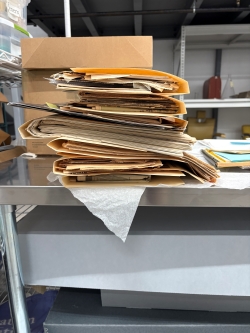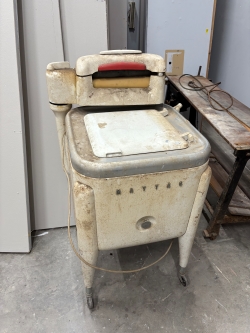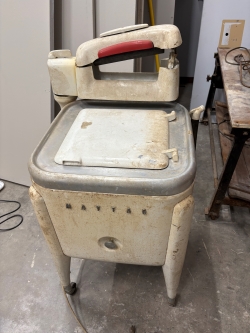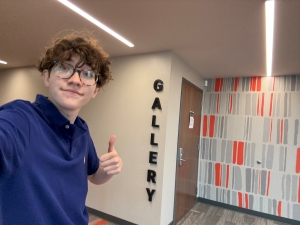I’ve been making very steady progress through the Wynn papers! Today, I managed to sort around 2 small boxes of papers. This week, in addition to processing, I’m setting my sights on a different project. Recently, the AAMI got a washing machine and other laundry items from the 1930s as a donation. These items once belonged to an African American woman who ran a laundry business from out of her basement to provide for her family. Since it’s been a while since the machines were used, let alone taken out of the basement, they gathered a bit of dirt, mold, and grime that needs to be cleaned off before we can move them into the collections storage area. If we moved them in now, we’d risk possibly spreading mold to other artifacts and archive papers, which would essentially destroy them. I’m hoping that the curator will let me help with the task!
More progress was made today! We’re already down to three moving boxes to sort through! As I’m sorting, though, I’ve come across a rapidly growing task for my future self: newspaper clippings. For now, I’ve just been putting them in a separate folder pile, but once I’m done sorting through the moving boxes, I’ll have to scan all of them so that we can preserve the information in them and not have to keep the originals.
But why do we not keep the originals, like we do with photographs? Newspapers are a bit different from photographs in that the paper that it’s printed on is very acidic, meaning that with time, it becomes increasingly fragile and is more prone to disintegrating or tearing. To combat this, we scan the newspaper clippings and print them out on acid-free paper, meaning that it will stay stable and intact for a long time! Since we have those copies, then, we don’t need the originals and often recycle them. Of course, there are exceptions to this rule, particularly when an entire newspaper is saved or when the clippings are too fragile to scan.

All the newspaper clipping folders as of 6/18/25
First and most importantly: Today is Juneteenth! A lot of people came into the museum today, since most people have the day off. It’s really nice to see the interest in Black history, even if it is once a year. But once a year is better than no times a year!
Today, I finally tackled the task of cleaning the washing machine. It was pretty filthy and rusty, so I was eager to get started!

The washing machine before…
First, I took a vacuum and did a once-over, picking up any loose dirt and debris. I had to be super careful and gentle so I didn’t accidentally scratch the machine or the paint. The first rule of conservation, as the curator informed me, is to not inflict any new damage. The worst of it was in the barrel of the machine itself, so I tried my best to get all the loose things up and off. Of course, some of the dirt was really caked on, so the vacuum didn’t do much to help there, but it got rid of fifty year’s worth of dust bunnies and cobwebs, which helped a ton.
The next step was the more labor-intensive one: the detail clean. Using chunks of a dense and dry sponge, I carefully loosened and removed any dirt that I could find that would come off with gentle movements. In some places, it made a world of a difference, and in others, not so much. After an hour and a half of gently wiping at spots and going over with the vacuum, I got it as clean as I could. Because of all the rust and paint flaking, there’s no way I would have been able to restore it to its former glory, but I did my best! Luckily, there wasn’t any mold either, which is a huge win!

…and the washing machine after!
It was so much fun to learn the basics of the conservation process! I had a blast cleaning up the washing machine, but I’m not entirely sure that a future in only conservation is one that I would enjoy very much. I would maybe need to have something else going on, or to do it on the side of something else. I’m really happy that I learned that today, since it’s something that I expected to really love. You learn something new every day, and today I certainly learned a bit more about what I want my future to look like.
Today, I got through nearly an entire moving box of Wynn papers! Now, I’m down to around two and a quarter to go, so I’m hoping I can finish sorting next week.
The main reason why I managed to get an entire box out of the way so fast (in a single morning, no less!) was because there were at least 70 copies of the same flyer and envelope. Normally, the museum doesn’t keep every single copy, since collection storage space is very precious. So, instead, we keep up to three copies of a flier, envelope, etc. and then reach out to other museums to see if they could use what we don’t have room for. Here in Cedar Rapids, that usually means we’re reaching out to the Historical Museum. Of course, they probably won’t take all 70 copies, but it’s still important to ask around. You never know who might need what you have.
In the afternoon, it was Front Desk Friday! Nothing too out of the ordinary happened, so I got to enjoy the view of the museum’s beautiful lobby!

Opening the Gallery for Visitors
Finally, today marks the end of my first month in my internship! It’s been a really fun month, and I’ve really enjoyed the collections work that I’ve been given. As I reflect on this past month and all the things I’ve learned, I realize that I’ve come a long way! When I started this internship, I only knew how to scan paper files and work a front desk, but now I’ve learned how to manage an entire museum catalog, file papers, photograph objects, the basics of conservation, and even how and where to store things. I’m so grateful to be learning these skills, because the further I get into this internship, the more I’m realizing that collections work is something that really inspires me! At Cornell College, I’ve learned a lot about the background information of Black history, and that has been so incredibly useful, because it is thanks to that that I know why these tangible things are so important. To me, that really makes all the difference. You learn so much more and have a much richer experience if you have the context and background that comes with the subject. It’s nice to look at objects, but it’s even better if you know what you’re looking at.